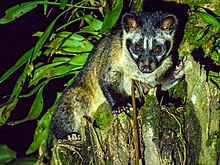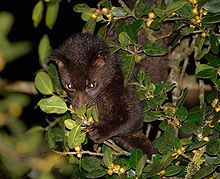Loading AI tools
Genus of carnivores From Wikipedia, the free encyclopedia
Paradoxurus is a genus of three palm civets within the viverrid family that was denominated and first described by Frédéric Cuvier in 1822.[3] The Paradoxurus species have a broad head, a narrow muzzle with a large rhinarium that is deeply sulcate in the middle. Their large ears are rounded at the tip. The tail is nearly as long as the head and body.[4]
| Paradoxurus[1] | |
|---|---|
 | |
| Asian palm civet (Paradoxurus hermaphroditus) | |
| Scientific classification | |
| Domain: | Eukaryota |
| Kingdom: | Animalia |
| Phylum: | Chordata |
| Class: | Mammalia |
| Order: | Carnivora |
| Suborder: | Feliformia |
| Family: | Viverridae |
| Subfamily: | Paradoxurinae |
| Genus: | Paradoxurus Cuvier, 1822 |
| Type species | |
| Viverra hermaphrodita[2] Pallas, 1777 | |
| Species | |
|
see table | |
 | |
| Paradoxurus ranges | |
The three species are the Asian palm civet, the Golden palm civet, and the Brown palm civet.[1]
Paradoxurus species have a broad head, a narrow muzzle with a large rhinarium that is deeply sulcate in the middle. Their large ears are rounded at the tip, the interior ridges and bursae are well developed. The skull exhibits marked muscular moulding, and the postorbital area is deeply constricted shortly behind the well-developed postorbital processes. It is considerably narrower than the interorbital area and than the muzzle above the canines. The dental formula is 3.1.4.23.1.4.2. The palate is not produced behind to cover the anterior half of the mesopterygoid fossa, and is flat and expanded between the posterior cheek teeth. The tail is nearly as long as the head and body, sometimes quite as long, and about six times as long as the hind foot.[4]
As of 2005, this genus was defined as comprising three species native to Southeast Asia:[1]
| Name | Image | Distribution |
|---|---|---|
| Asian palm civet, P. hermaphroditus (Pallas, 1777)[5] |  |  |
| Golden palm civet, P. zeylonensis Pallas, 1778[6] |  | Sri Lanka |
| Brown palm civet, P. jerdoni Blanford, 1885[7] |  | Western Ghats, India |
In 2009, it was proposed to also include the golden wet-zone palm civet (P. aureus, Cuvier, 1822), the Sri Lankan brown palm civet (P. montanus, Kelaart, 1852) and the golden dry-zone palm civet (P. stenocephalus, Groves et al., 2009), which are endemic to Sri Lanka.[8] A subsequent study found very low genetic diversity and no geographical structure within the golden palm civet and did not support the proposed split.[9] Comparison of morphological data indicate that the Asian palm civet comprises three major clades that should be recognized as separate species: namely one in the Indian subcontinent and Southeast Asia (as Paradoxurus hermaphroditus sensu stricto), one in Sumatra, Java and other small islands (Paradoxurus musanga), and the third in the Philippines and the Mentawai Islands (Paradoxurus philippensis).[9] Genetic data, however, do not support species level distinction.[10]
Seamless Wikipedia browsing. On steroids.
Every time you click a link to Wikipedia, Wiktionary or Wikiquote in your browser's search results, it will show the modern Wikiwand interface.
Wikiwand extension is a five stars, simple, with minimum permission required to keep your browsing private, safe and transparent.